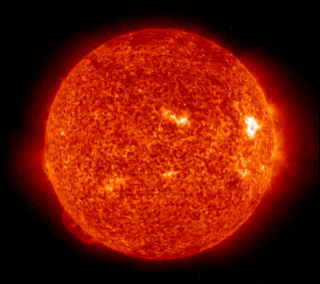The Boston Sun had some sizzling photos of the Sun in all it's yellow glory recent.

A six day animation of the sun, taken by NASA's Extreme ultraviolet Imaging Telescope (EIT) and filmed in June 2005.
 "A sweeping prominence, a huge cloud of relatively cool dense plasma is seen suspended in the Sun's hot, thin corona. Emission in this spectral line shows the upper chromosphere at a temperature of about 60,000 degrees K (over 100,000 degrees F). The hottest areas appear almost white, while the darker red areas indicate cooler temperatures."
"A sweeping prominence, a huge cloud of relatively cool dense plasma is seen suspended in the Sun's hot, thin corona. Emission in this spectral line shows the upper chromosphere at a temperature of about 60,000 degrees K (over 100,000 degrees F). The hottest areas appear almost white, while the darker red areas indicate cooler temperatures." A total solar eclipse, February 16, 1980, in Palem, India
A total solar eclipse, February 16, 1980, in Palem, India A sunspot and granules on the Sun's surface.
A sunspot and granules on the Sun's surface. An erupting solar filament. "Filaments are concentrated bundles of magnetic field filled with relatively cool gas, suspended in the solar corona. When they become unstable, they can erupt, triggering coronal mass ejections and solar flares. The dark material here is relatively cool, while the bright material is hotter than a million degrees. As this hot material cools, it condenses and drains down the lines of magnetic field in the corona much like beads moving along a wire, a process some scientists refer to as "coronal rain"."
An erupting solar filament. "Filaments are concentrated bundles of magnetic field filled with relatively cool gas, suspended in the solar corona. When they become unstable, they can erupt, triggering coronal mass ejections and solar flares. The dark material here is relatively cool, while the bright material is hotter than a million degrees. As this hot material cools, it condenses and drains down the lines of magnetic field in the corona much like beads moving along a wire, a process some scientists refer to as "coronal rain"." A visually stunning prominence eruption, seen in extreme UV light. "It rose up and cascaded to the right over several hours, appearing something like a flag unfurling, as it broke apart and headed into space. The material observed is ionized Helium at about 60,000 degrees."
A visually stunning prominence eruption, seen in extreme UV light. "It rose up and cascaded to the right over several hours, appearing something like a flag unfurling, as it broke apart and headed into space. The material observed is ionized Helium at about 60,000 degrees." 


0 comments:
Post a Comment